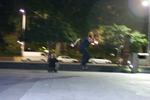Usb Faceplate
This mod involves mounting two USB ports on a 3.5" blank faceplate for easier access.
<gallery>384;Prototype</gallery>
Getting started:
Here is an image of my ASUS USB Ports detached from the backing plate. Notice the black texta on the board. If you go over a hard surface with texta, it makes it easier to see markings on it. Scratched in the texta is a line showing where to cut and a crosshair showing where to drill.
You will need the following hardware:
Mounting:
Screws/Nuts/Spacers depending on how you wish to mount yours. I did some digging around in my spares and found some cool little aluminium extrusions with M3 threaded holes 90 degrees opposed on the Y axis. You could use a simple 'L' bracket if you wanted.
<gallery>2423;Nuts, Bolts, Offsets</gallery>
<gallery>394;90 deg offsets</gallery>
A note about hacking up the board. When you do this you are severing connections (duh). Before you do this trace the tracks on the board and make sure you don't have the same problem I did. When I cut the board and drilled the new hole, there was a short somewhere (caused by the screw head shorting two tracks where I had drilled.), what I did to resolve this was to test the tracks and then scrape some off around the screw. The short was between the +5v and the 0v, so that would have possibly fried something if I wasn't careful. I am not sure what sort of protection is on USB...
Half a chip carrier is what I am using. You could use anything really. Its up to you. Prototype board is also good. You will also need some components.
I am using two BC548 transistors, two 100 ohm (brown black brown gold) 1/4 watt transistors and two green LEDs. In the picture you can see my component tray with various transistors, my hacked up USB lead, my breadboard (the beige thing with all the holes in it) and a baggie of LEDs. You can also see my Milo. That is optional.
In the breadboard you can see two chips. I didn't end up using them. I was going to do it with a pair of NAND (4011 Quad Two Input NAND) gates and some inverters (4069 Hex Inverter), but transistors were easier and smaller =)
<gallery>391;Prototype</gallery>
<gallery>396;Proto Board</gallery>
Here are some of the pictures of my circuit in development. You wont have to do this though. The green cord and the stylus are from my graphics tablet. I was using it to experiment with. Two circuits I have here are only slightly different.
One hooks up with the base of the transistor on the data line. This means the LED stays dimly lit with brighter flickers when there is lots running down the bus. The other has the base sitting on the +3.3 supply so when something is plugged in the LED just turns on.
I was thinking of putting a dual colour LED in there so that it would flicker the other colour when there is high traffic. However the "CBF" factor was too high. And I wanted my USB ports =)
<gallery>385;Prototype with LED</gallery>
<gallery>2424;Prototype with LED</gallery>
Tools:
Soldering Iron, Screwdriver, Side Cutters or Wire Strippers, A nibbler or file, 3, 5 and 7mm Drill, Something to use the drills in (duh).
Space:
You must have it to put the ports in. My ports ended up protruding about 50mm into the 3.5" bay. I suggest you don't have a hard drive in the bay as well.
OK To the design. You must measure the width and height of your 3.5" bay clip in cover. Measure the inside, not including the width of the plastic. Its easier than sticking stuff on the front. Once you have done that. Measure up your ports and work out how you are going to mount them. Then work out how you are going to mount your LEDs. Use your favourite CAD package (Design CAD Pro 2000) to draw yourself a template.
Here is a screen cap of my drilling template. With a drilling template its possible to cheat - i.e. make it easier. You do this by sticking the template onto the clip in cover. This is why I have a vertical and horizontal line spanning the entire width and height of the drawing. You only need to find the centre on each side rather than measuring and marking each hole. Sure its not as accurate, but after doing a couple you get used to it. (Look at my LCD, its crooked, 3 guesses how I did that =))
<gallery>397;CAD Drawing</gallery>
As you can see I have my cut outs in red. There are two 5mm holes at the top centred above each port for the LEDs, 3.5mm holes for the screws to hold in the board and finally two 7mm holes so I can fit the nibbler in to cut out the holes.
Once you find the centre on each side of the clip in panel, cut out your drawing and stick it in.
After lots of drilling, swearing and filing you get this: (if you are lucky)
<gallery>2416;Face Plate</gallery>
OK, now that you have space and you have something to mount the ports and board in, start soldering! =) Here is a circuit diagram for you. (damn I love Visio) You will need two of these circuits. One for each port.
Diagrams for LEDs and Transistors.
Notice that the circuit is passive, it does not connect in series with the port, you are just linking to 3 of the 4 lines on the bus.
<gallery>399;Circuit Diagram</gallery>
<gallery>2425;LED</gallery>
<gallery>398;Transistors</gallery>
Now you should have something looking kinda like this: Mine isn't finished in the picture though.
<gallery>386;Nearly Done!</gallery>
Almost there!
What you need to do now is mount the ports and the LED board in the face plate. In the picture you can see I had insulation problems, so there is an abundance of tape =) Professional mounting job as you can see.
<gallery>2422;Rear</gallery>
<gallery>392;Top</gallery>
A note on cabling.
Think about what, in computer terms scares the shit out of you. That's right, losing your HDD.
Here is my best explanation for the weird noises I was getting from my HDD. The drive was repeatedly spinning up and the head was then retracting really quick and banging on its stopper making a "wirrrrr tink tink tink" noise repeatedly. So I unplugged my USB stuff and it was fine...
As you can see there is grey insulation around my USB ribbons. The reason for this that I believe my unshielded USB ribbons were interfering with my IDE ribbon. So what I did was stripped some 25 way (fat) data cable taking care to keep the foil shielding and insulation in one piece. I wrapped the ribbon in the foil and then placed the insulation over the top. After that I secured it with tape.
The hard drive problem has since stopped.
As you can see here are the new shielded ribbons installed. and a few images of the front of the case now. You can also see the 80mm fan on my voodoo =P
<gallery>390;Complete</gallery>
Troubleshooting:

Always always ALWAYS check your stuff before connecting it.
A few problems that I ran into and how I resolved them:
- Solder run across board to other pads.
- Run the tip of the iron down the centre of the two pads, this usually fixes it. If not use some wick or a solder sucker to remove the solder and do the joint again. I mean re-solder it not toke...
- It doesn't work at all. Heres where we get the test gear out. Check your joints, check your wiring, check everything, test everything and then if it still doesn't work, start resoldering cables/components and checking them individually.
- Use your multimeter (or voltmeter) whichever you have to check you are getting +5v from the USB.
- Check your connector from end to end with a continuity meter, also check the USB pins with each other to see if they are shorted.
- When you hacked up the board did you mess up some circuits?
- When you put the nut/bolt or screw into the board did it short anything?
- Are your LEDs around the right way?
- Are your Transistors around the right way?










